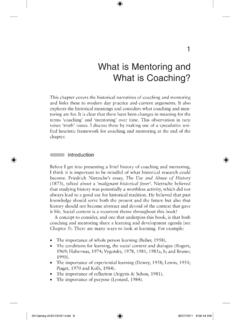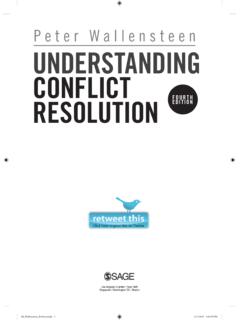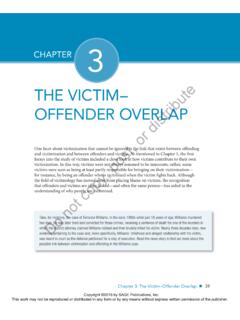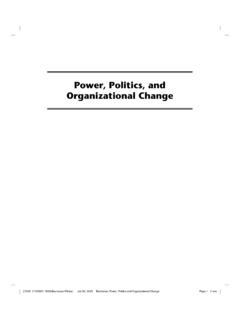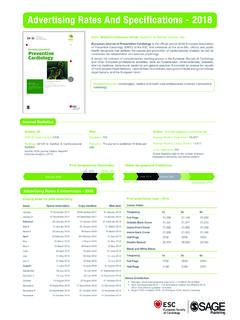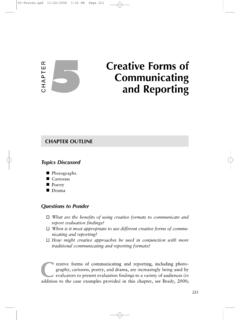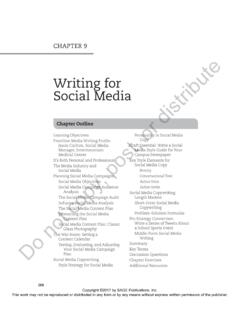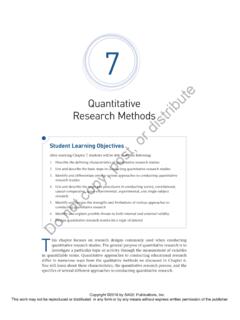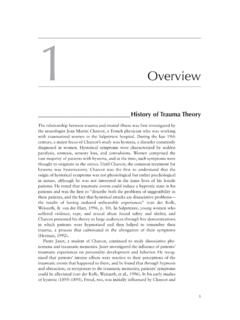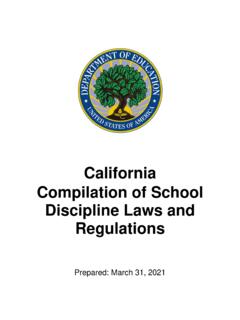Transcription of CULTURALLY RESPONSIVE STRENGTHS ... - SAGE Publications …
1 CULTURALLY RESPONSIVE . 1 STRENGTHS -BASED THERAPY. The Journey e ut rib CHAPTER OBJECTIVES. What lies behind us and what lies before us are tiny matters compared to what lies within us. Henry 1. Contextualize the multicultural S. Haskins and Nock, 1940. t movement in the helping professions. is We developed a multi-faceted prejudice habit-breaking 2. List and define several key concepts in intervention to produce long-term reductions in implicit cultural counseling . d race bias. The intervention is based on the premise that 3. Explain the role of neuroscience implicit bias is like a habit that can be reduced through a in understanding the cognitive or combination of awareness of implicit bias, concern about processes that lead to conscious and the effects of that bias, and the application of strategies to unconscious racial, ethnic, cultural, reduce bias.
2 Patricia Devine, Devine, et al, 2012. and gender bias. t, It's not what you look at that matters, it's what you see. 4. Evaluate whether there is a new s Henry David Thoreau, 2012. paradigm of implicit and explicit po racial bias that will influence multicultural competence and training. INTRODUCTION: THE JOURNEY TO 5. Describe the relationship among , BECOMING A CULTURALLY RESPONSIVE neuroscience, racial bias, and cultural py STRENGTHS -BASED THERAPIST STRENGTHS as an emerging framework for CULTURALLY RESPONSIVE counseling /. All life is a journey. From the day we're born, we each embark on a psychotherapy. co journey called life. There are over billion people in the world, yet no two journeys are exactly alike.
3 Our life journeys are fueled 6. Utilize the clinical skills of cultural by our families, friends, beliefs, values, struggles, challenges, awareness, cultural humility, and injustices, and dreams. This book is designed to take you, the reader, cultural empathy. t on a journey where you will encounter yourself as a cultural human no 7. Understand how your own cultural being, and where you will come face-to-face with who you are background and family experiences CULTURALLY . By taking this journey, you will better position yourself have influenced your cultural to counsel or provide therapy to those who are CULTURALLY different worldview and outlook. from you. Once you begin, you will realize that cultural competence o in counseling others is a lifelong journey.
4 D. The journey toward gaining cultural competence begins with our awareness of culture and the impact it has on our own lives as well as the lives of others. Centuries ago, Socrates said that the unexamined life is not worth living. One of the critical factors we must examine is our 1. Copyright 2019 by SAGE Publications , Inc. This work may not be reproduced or distributed in any form or by any means without express written permission of the publisher. 2 CULTURALLY Diverse counseling culture and the effect it has had, not only on our own lives but also on the lives of those whom we seek to counsel. For instance, I have become a richer person as I have considered my many influ- ences and the varied tapestry that constitutes my life.
5 I am who I am because I was dipped in dif- ferent cultural waters, with different people having various skin colors, hair textures, languages, values, and geographic places of origin. Each day I live out my tripartite level of being that is, I know on a deep level three facts: I am like all other people (universal level of experience), I am like some other people (cultural and ethnic level of being), and I am like no other person in the world (unique individual level of experience). This book places an emphasis upon culture, cultural e STRENGTHS , and human STRENGTHS . Culture encompasses virtually all that we believe, value, and do. We are first and foremost cultural beings. ut rib THE PROFOUND INFLUENCE OF CULTURE.
6 Culture is the force that humanizes each one of us; it plays a key role in determining who we are;. t what we think; what we eat; the music that we listen to; what we believe about men, women, and is the family; and how we respond to our environment. Culture is probably one of the most powerful forces in the world far more powerful than guns or airplanes carrying bombs. In fact, culture d is what exists long after the bombing is over. Each person is born into a culture that shapes and influences how he or she views the world what researchers have called a worldview (Cheung, or van de Vijver, & Leong, 2011; Jones-Smith, 2014; McAuliffe & Associates, 2013; Sue & Sue, 2013). Culture has assumed a pivotal role in making me who I am and in making you who you are.
7 The influence of culture is so profound that it affects us even before our actual birth. From the time of one's birth (and possibly even during stages of development in the womb), the brain is t, organized to prefer or to lean toward the culture of the mother. A mother's womb is a child's first s cultural experience. In the womb, a baby is exposed to cultural food; sounds of living, includ- ing music; and the ebb and flow of culture as the mother experiences it. Even the birth process is po influenced by the culture of the people who attend to the mother. Certain cultural responses are made to signal the birth of a child (Rosenberg & Trevathan, 2003). Culture may be defined as the sum of intergenerationally transmitted lifestyles, behav- ior patterns, and products of a people that involve their language, music, art, artifacts, , py beliefs, values, history, eating preferences, customs, and social rules (Harper & McFadden, 2003).
8 People learn their cultures through a process of enculturation; that is, they learn skills needed to function in a particular society. The family and the community are the co major transmitters of culture. The cultural rules each ethnic group adopts are not universally or consistently obeyed; yet, all members recognize them, and individuals usually live by limiting the range within patterns of communication, beliefs, and social behavior found in cultures. Each culture produces (a) shared t ways of behaving among group members, (b) a basic motivational structure for behavior, and no (c) psychological needs within its members. Culture is an inevitable silent partner in counseling .
9 counseling is a culture-specific human invention. Each form of counseling reflects the culture that produces it. Culture guides our behavior and provides the framework for observing and identifying problems. Culture also teaches people problem-solving behaviors. o Studies have revealed that culture influences the meaning that individuals D. give to their symptoms and to the cause and implications of the personal dif- Cultural Reflections ficulties they experience in life (Andrade, 2017; Gopalakrishnan & Babacan, What is the cultural relevance of your 2015; Huang & Zane, 2016). For example, in Italian and Jewish families, name? members may use emotional expressiveness to share personal suffering, while What values, beliefs, and attitudes do those from Scandinavian, Asian, and American Indian backgrounds may you subscribe to that are consistent with be inclined to withdraw and not discuss their feelings.
10 The Euro American the dominant culture? worldview that dominates counseling subscribes to the values of rugged indi- vidualism, competition, and individuals' mastery over nature (Katz, 1985). Copyright 2019 by SAGE Publications , Inc. This work may not be reproduced or distributed in any form or by any means without express written permission of the publisher. Chapter 1 CULTURALLY RESPONSIVE STRENGTHS -Based Therapy 3. OUR BRAINS ARE CULTURALLY CONNECTED. Culture's profound influence has been shown in recent studies that demonstrate that culture affects one's biology in that it organizes one's brain rather than the other way around. For instance, a study by Zhu, Zhang, Fan, and Han (2007) found that American brains function differently when they consider traits of themselves versus traits of others, while Chinese brains function the same whether considering their own traits or the traits of others.
